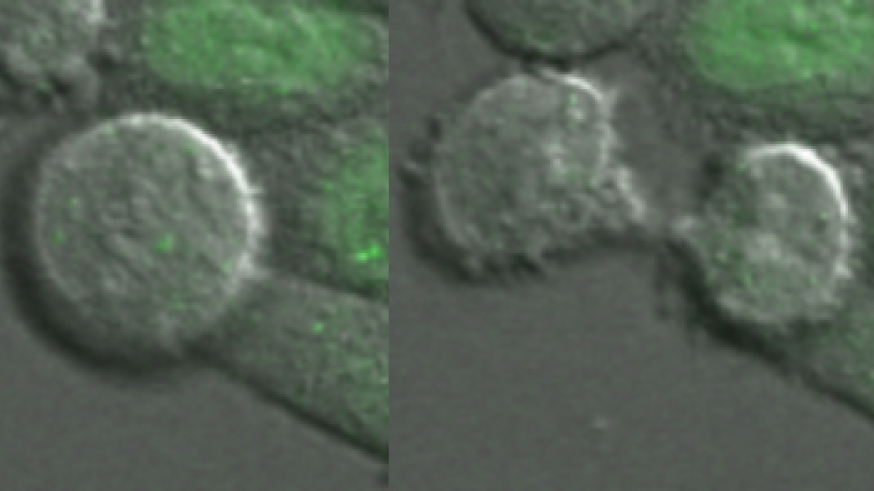
Photo: Dr Chris Bakal
Cells are able to remember that DNA damage has occurred as they pass through the process of cell division, a new study reveals.
Researchers found that a protein called p21 acts as a signal of DNA damage within daughter cells after division – so damage can be repaired before being passed on further.
Since cancerous cells develop when genetic damage is left unchecked, the research could improve our understanding of what goes wrong in the lead-up to cancer.
It could also help researchers develop new ways to kill off cancerous cells.
The work, led by scientists at The Institute of Cancer Research, London, and published in the journal Nature Communications, found that high levels of p21 build up in cells that incur DNA damage as they divide.
After the division, the two daughter cells still contain high levels of p21 – and if these levels are great enough, the cells enter an arrest state, unable to grow and divide any further. This prevents the genetic mutations from being passed on.
Cell watching
The research team, led by Dr Chris Bakal and involving researchers from universities such as Imperial College London and the University of Oxford, first came across the phenomenon while studying non-cancerous cells for signals that would indicate the occurrence of cancer-inducing events.
To do this, they inserted a fluorescent tag into the genes that code for proteins such as p21, which allowed them to track the cells’ production of these proteins by monitoring for fluorescence.
They consistently found that around 17% of the cells produced p21, which is normally expressed in cells with DNA damage caused by radiation exposure. When radiation damage happens, p21 helps to stop the cells from dividing and passing mutations on to their descendants.
This suggested that these cells were experiencing DNA damage during their normal life cycles.
Mutations can and do occur during the process of cell division itself, when DNA is copied incorrectly, but very few of these mutations are allowed to continue down the generations – far fewer than 17%.
“This told us that p21 plays an important role in maintaining DNA stability,” said Dr Bakal, Leader of the Dynamical Cell Systems Team at the ICR.
No rest
However, the team also found that this p21 expression did not lead to immediate repair. Instead, the cells continued to divide, passing on both the DNA damage and the p21 levels to their daughter cells.
It was then at this point that the cells took one of two paths. In those with high p21 levels, the cell division process halted, allowing DNA repair to begin.
In those with lower levels, the p21 was removed, allowing the cycle to continue and the cell to divide once again.
“Not only does this indicate that p21 is involved in halting division in cells that incur damage during DNA replication,” explained Dr Bakal, “but it also suggests a way to develop new treatments that kill cancerous cells.
“If the p21 clearance mechanism can be exploited to prevent a build-up of p21 in tumours after radiotherapy, then these cells will not enter a phase of repair, and should be more likely to die as a result.”
The research was funded by grants from the Biotechnology and Biological Sciences Research Council and the German Research Foundation.